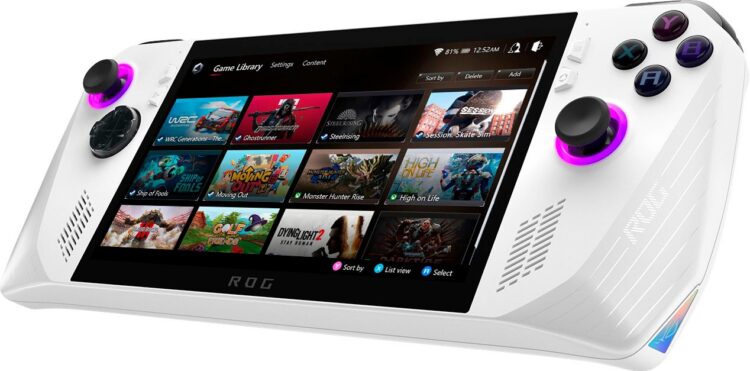Asus is entering the handheld PC gaming space with its own machine called the Asus ROG Ally, which is set to take on others in the space, including the Steam Deck and Ayaneo’s various devices. While the device is available for preorder, there seems to be some confusion regarding it, as there are two variants. So, we’re here to help clear up that confusion and help you decide which one to acquire.

There are two versions of the ROG Ally, one that packs the AMD Ryzen Z1 Extreme, priced at $699.99, and the other version, priced at $599.99, which has the less powerful AMD Ryzen Z1 processor.
This is what the $699.99 Asus ROG Ally version features:
- Processor: AMD Ryzen Z1 Extreme (8-core, 16-thread) clocked up to 5.10Ghz
- Graphics: AMD RDNA 3 with 12 CUs, up to 2.7Ghz
- Memory: 16GB 6400MHz LPDDR5 RAM
- Storage: 512GB PCIe 4.0 2230 NVMe SSD
- Battery: 40Whr (lasts 2 hours under heavy gaming, 5-6 hours with light gaming and media consumption)
- Display: 1920 x 1080 (16:10 aspect ratio), 120Hz, 7-inch adaptive sync IPS touchscreen, 500 nits
- Dimensions: 11 x 4.37 x .83 inches
- Weight: 608 grams / 21.44 ounces (actually lighter than the Steam Deck)
- Connectivity: Wi-Fi 6E, Bluetooth 5.2, 2 x USB-C with DisplayPort 1.4 Alt-mode support, 1 x 3.5mm headphone/microphone combo jack, UHS-2 TF card reader, ROG XG Mobile GPU interface
- Additional features: Fingerprint reader, programmable RGB LED thumbstick rings, Dolby Atmos virtual surround sound, Hall Effect triggers with adjustable actuation and haptic feedback
Then there’s the cheaper variant that is priced at $$599.99, a hundred-dollar difference, that will come packed with a less powerful version of the CPU, the AMD Ryzen Z1. This device is now available for sale at Best Buy.
Here’s what the $599.99 Asus ROG Ally version features:
- Processor: AMD Ryzen Z1 (6-core, 12-thread) clocked up to 5.10Ghz
- Graphics: AMD RDNA 3 with 12 CUs, up to 2.7Ghz
- Memory: 16GB 6400MHz LPDDR5 RAM
- Storage: 512GB PCIe 4.0 2230 NVMe SSD
- Battery: 40Whr (lasts 2 hours under heavy gaming, 5-6 hours with light gaming and media consumption)
- Display: 1920 x 1080 (16:10 aspect ratio), 120Hz, 7-inch adaptive sync IPS touchscreen, 500 nits
- Dimensions: 11 x 4.37 x .83 inches
- Weight: 608 grams / 21.44 ounces (actually lighter than the Steam Deck)
- Connectivity: Wi-Fi 6E, Bluetooth 5.2, 2 x USB-C with DisplayPort 1.4 Alt-mode support, 1 x 3.5mm headphone/microphone combo jack, UHS-2 TF card reader, ROG XG Mobile GPU interface
- Additional features: Fingerprint reader, programmable RGB LED thumbstick rings, Dolby Atmos virtual surround sound, Hall Effect triggers with adjustable actuation and haptic feedback
As you can see from the specs, the only difference between the two is the CPU, which can make a world of difference. As of the release of the Asus ROG Ally with the Z1 processor, it has been shown to have a 10-15 minute longer battery life.
Which one is worth your money?
Well, that’s always the million-dollar question, isn’t it? Since we don’t have metrics for the lower-powered variant of the Asus ROG Ally, we can only go off what we know of the AMD Ryzen Z1 Extreme-powered variant. Given that this does provide ample performance over the Steam Deck and its competitors, it’s a safe bet that this would be the one to get. We’ve seen how it performs in multiple games, and we’ve seen its emulation chops. However, donning my speculation hat, I suspect that the AMD Ryzen Z1-powered ROG Ally won’t be a slouch either.
Then there’s the Steam Deck, which is currently available and does a moderate job of playing games at low to medium settings. I currently own one, and while I enjoy playing on it, I wouldn’t mind a better experience. The more expensive Steam Deck is priced at $650, and either of the ROG Ally’s will outperform it. So there’s that, as well as a better screen. But on the other hand, the Ally doesn’t have that trackpad that I love so much. There’s definitely something that each device provides.
At the end of the day, I’d say that anyone who’s about to drop this much money on either the Asus ROG Ally or even the Steam Deck should just wait until all of the variants are available and wait to see what the reviews are. Or if you don’t care, the rule of thumb is always to go with the most powerful one.
Just keep in mind that I am still wary of the ROG Ally only because it runs Windows 11, and even on my gaming PC, I have to do a nice amount of tuning to get it to perform better. That and there are always issues with any device’s first release. Just keep that in mind.

